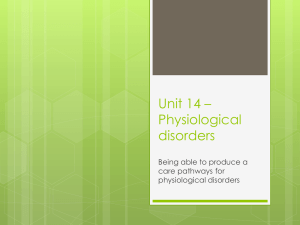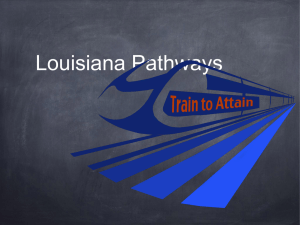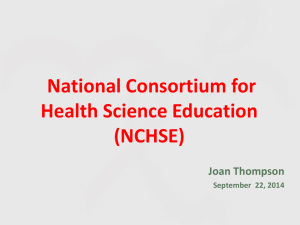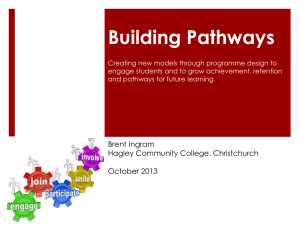P4 Healthcare
advertisement
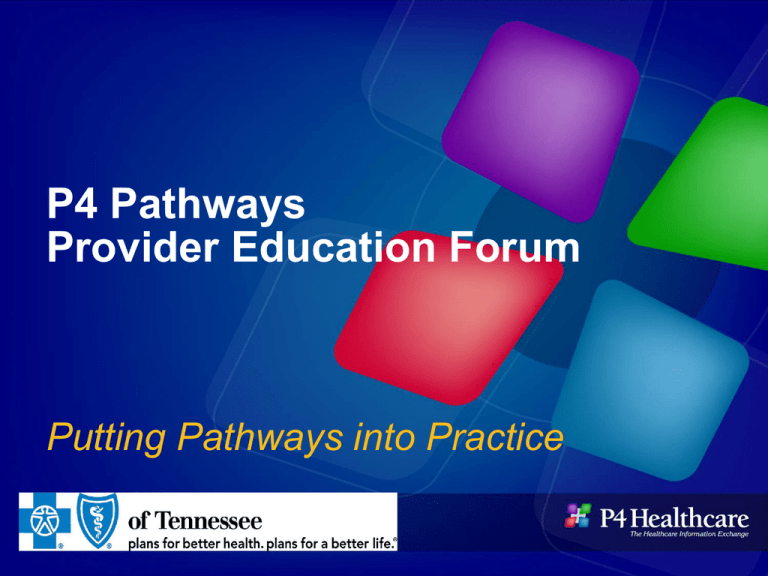
P4 Pathways Provider Education Forum Putting Pathways into Practice CANCER TREATMENT PATHWAYS Provider Education Forum Pathways Program June 24, 2010 Time Agenda Topic 7:00 p.m. Welcome & introductions 7:10 p.m. Program overview 8:15 p.m. Q&A 8:30 p.m. Adjournment ONCOLOGY INCHES CLOSER TO BEING PAYERS’ TOP TARGET Why control Oncology Rx? Within the next 12 months, our plan will do the following regarding oncology management: 40% 35% 32% 30% 22% 20% 11% 10% 0% Develop internal oncology management program Partner with oncology management vendor Partner with specialty pharmacy vendor None of these in the strategic plan at this time What do you view as the most important way for your plan to save money in oncology long term? 69% 70% 60% 50% 40% 30% 20% 10% 0% 18% 9% 2% Reduce chemotherapy fee schedule Maximize referrals to hospice Prior authorization of chemotherapy regimens 2% Practice guidelines Brown bag (drop ship drug to patient to take to doctor for administration) Assume your carrier has partnered with a third party to manage oncology costs. Which is most acceptable to you? 50% 42% 40% 40% 30% 20% 10% 10% 0% 6% 2% Reduce fee Provide a monthly Provide a monthly Implement Implement schedule and fee for management fee, pathways but pay pathways but pay include prior chemotherapy but send patients to me more for me a management authorizations to management ,but a free standing participation (ASP + fee rather than high manage therapeutic supply drug via infusion suite 27%). drug payments choice, but do not brown bagging (ASP + 12% plus a utilize pathways cancer (ASP + 12%, higher management fee) generics) Changing the Paradigm Fee Schedule Manipulators Balanced Approach Pathways Program Why P4? Decade of Oncology Advocacy Commitment to Community Oncologists Established Managed Care Initiatives • Existing Contract • Pending Contracts Demonstrated Success • Payer and Physician Satisfaction • Enhancing Physician Income Scalable Technology Agnostic to EMR, Distributor and Class of Trade BCBST Program 300 ~ Oncologists between community and academic practices • ASP + 27% versus ASP + 20% for most antineoplastic and supportive care drugs • Higher reimbursement for generics • Medicaid effective June 30, 2010; Commercial effective September 7, 2010 • Participation = Maintaining compliance in clinical pathways for breast, colon, lung, ovarian and supportive care. Year one compliance is 70% for treatment and 80% for supportive care Pathways Program Objective To increase quality and cost effectiveness through the implementation of standard, evidence-based, oncology clinical pathways for breast, colon, lung, and ovarian cancer and for supportive care. These will be followed by prostate, multiple myeloma, CLL, follicular lymphoma, mantle cell, and large B cell lymphoma in year two. Year three will include additional pathways and diagnostic testing. Goals of the Pathways Utilization of a consistent treatment regimen based upon a balance between outcomes, toxicity, and cost. Treatment pathways will: • Be based upon the scientific and clinical literature • Provide a standard approach to the patient (reduce misuse, hospitalizations) • Decrease variability of regimens utilized, including “off label” indications • Clearly define treatment endpoints and treatment milestones Treatment consistency resulting from treatment pathways will lead to: • Optimal outcomes • Minimizing and better management of toxicities • Allowing for a greater predictability of treatment cost Treatment Pathways Implementation 30 to 90 Days Pathway Development Provider Education Network Development •Developed by a Regional Steering Committee using P4 pathways as a starting point •Evidenced-based looking at efficacy, toxicity, and costs •Pathways will be fully referenced with FN risk levels and Hesketh scores •General membership has commentary period before going into effect •Quarterly updates •Utilizing mail, e-mail, provider meetings, web conferences, and site visits •Dedicated provider web portal (includes program description, Pathways, fee schedules, Q&As, eobONE information, fax form, contact us, registration page, recorded web conferences, and compliance module •Recruitment from BCBS Tennessee’s participating network panel •Physicians register for the program by executing a Declaration of Participation and receive a welcome packet that includes credentials to secure areas of the program’s web portal •eobONE contracting, installation, and training Roles and Responsibilities: BCBST No change Maintain provider panel Define Fee Structure Determine Coverage Utilization Management • Prior Authorization • Post Payment Reviews Roles and Responsibilities: Physicians No Major Change Provide Care to Patients Determine appropriate choice for individual patient Develop and Update Clinical Pathways through a Steering Committee Participation in the Pathways Program is optional – Pathway Adoption – eobONE Installation or the ability to provide ANSI 835 & 837 files – Adequate Compliance – Pass or Fail Roles and Responsibilities: P4 Pathways Contract with BCBST Coordinate the Development of Regional Oncology Clinical Pathways Communications to Membership – Clinical Pathways – Pathway Updates and Revisions – Fee Schedules Compliance Measurement Compliance Reporting – Physician – Practice – BCBST Pathway Development Process Sample P4 Pathways Presented to Physician Steering Committee Steering Committee Breaks into Sub-Committee groups for Pathway Development Full Steering Committee Reviews and Finalizes Draft Set of Pathways Pathways presented to BCBST for Review Pathways presented to full membership for commentary Final Pathways referenced and formalized The Golden Rules • Choice of treatment should always be guided by Efficacy if clinically relevant • If Efficacy between therapeutic alternatives is equal then Toxicity might drive choice • When Efficacy and Toxicity are similar among regimens, Economics should drive utilization The Challenge is the Misalignment of Economic Drivers Of Stakeholders The Most Important Rule The treating physicians have ultimate decision regarding treatment. At no time should patients receive sub standard therapy because of Pathways. The Pathways Project recognizes that not all patients can be cared for using a limited set of pathways. Compliance is set to allow individual treatment. Pathways Guidance Must be driven by data and best practice • PRIMARY LITERATURE • NATIONAL GUIDELINES • NCCN • Professional societies (ASCO, ASH, GOG, RTOG) Exhaustive enough to cover 90% of the eligible patients Plan designed to allow outliers When Pathways Physician Steering Committee identifies equivalent therapy, economics are considered Clear mandate that physician has ultimate control of treatment decision at point of care Pathways Maintenance Independent board will review and modify Pathways quarterly or after sentinel work to modify Pathways Process is transparent Members of Pathways Physician Steering Committee will rotate with other members of the regional oncology community as needed Cost Matters When data is equivocal then cost matters • Lower practice expense / Higher ROI • Lower out of pocket for patients • Savings for plan = Lower Premium to Employers How We Handle Clinical Trials Clinical Trials are a key aspect of Oncology care and are considered on pathway Patients without standard options should be considered first for trial before ineffective therapy Coverage of clinical trials challenging but should consider usual cost of care including standard drugs. Drugs outside of label should be provided at no charge by drug company. Compliance Determinations BCBS Tennessee, eobONE and Fax Form data run through compliance algorithm Sample Chart Audits to validate data Data sent to providers and posted on the web portal Physicians review scores and appeal relevant adverse determinations Final Compliance set at the practice level on a quarterly basis eobONE results in a higher level of cash reimbursement & improved staff productivity •Find EOBs in seconds • Increases “first-time paid” claims • Maximizes the “crossover” of your Medicare claims • Increases your recovery rate—find claims that are paid a rate of “zero dollars” • Increase your staff’s productivity immediately • Decrease your denial rate/increase your recovery rate • Decrease your real days outstanding • Available to BCBS Tennessee providers at reduced price of $600/physician/year www.eobone.com eobONE Data Capture eobONE = EOB + Claim ICD-9 Codes (from claim) J-Codes (from claim) HCPCS Codes (from claim) Billing and Collection data/behaviors Drug regimens/treatment patterns Supportive care Physician visits – office and hospital Payment – when, what, how much, denials, delays Extrapolation Diagnosis Regimen Treatment Schedule Dose delays/ reduction, reduced cycles, patient breaks, etc. Longitudinal Capture 26 P4 Pathways Physician Portal Treatment Compliance Supportive Care Compliance NonCompliance Reconciliation BCBST/P4 Pathways Case Management Referral Process Sample Pathways Final Pathways To Be Published Prior to the Program Effective Date Breast Cancer Treatment Pathways Adjuvant Breast (Lower Risk) – Node Negative, Her2Neu Negative • Clinical Trial • Hormone Therapy • Anti-estrogen • Aromatase inhibitor • Chemotherapy (cross-referenced with pertinent Hesketh (H) score and febrile neutropenia (FN) risk level) • AC - doxorubicin (Adriamycin®) and cyclophosphamide (Cytoxan®): H5, FN 10%-16% • CMF - cyclophosphamide (Cytoxan®), methotrexate, and fluorouracil: H5, FN 10%-16% • TC - docetaxel (Taxotere®) and cyclophosphamide (Cytoxan®): H5, FN>17% Wrap-Up/Questions Adjournment
